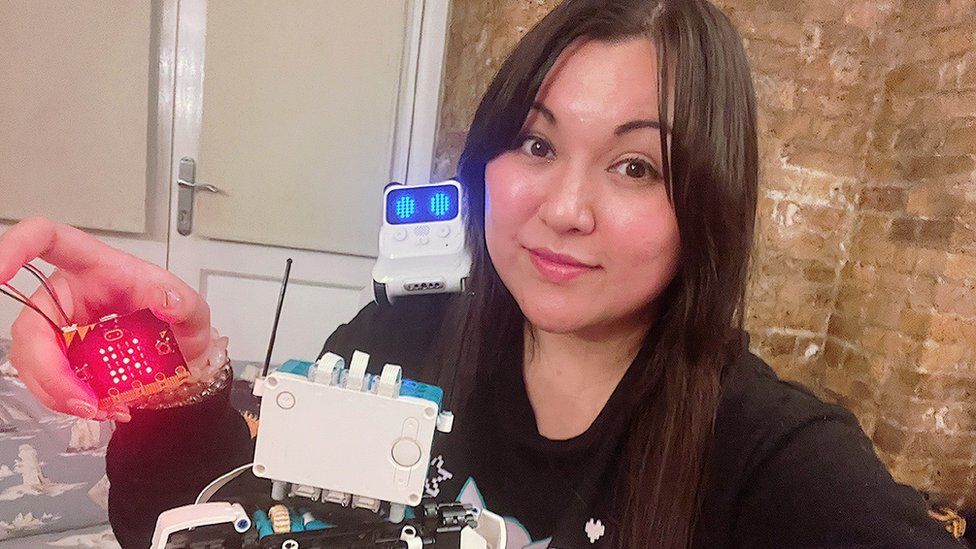What can we do to get more women into coding?
- Published

The UK is facing an acute shortage of workers with digital skills - computer coders, cybersecurity experts and data analysts, are all in high demand.
And it's not just a problem for the UK: globally, two-thirds of technology firms are experiencing a shortage of skilled workers, according to a recent report by recruitment firm Harvey Nash.
Its survey of 2,100 firms also showed that the proportion of women that make up technology teams has only been creeping very slowly higher - standing at only 25%, while just 12% of top technology executives are women.
So, given such startling statistics I decided to find out how easy it would be for a woman in her 30s, to learn to code in Python.
In case you are wondering, Python is a powerful, general purpose coding language and often the first language taught to undergraduates on computer science courses.
It is widely used in business - YouTube, for example, is largely written in Python.
Coding: How hard is it to learn?
Getting started
At the moment, if you want to learn to code, you need to pay for a class, teach yourself using online resources, or find a community willing to show you the ropes for free.
I thought I might have a bit of a head start here, having taught myself languages used to build websites back in the early 2000s.
So, I assumed I would be able to teach myself Python.
The first place I started was children's computing toys, hoping the goal of making robots move would keep me engaged and motivated.
But I quickly realised I was out of my depth - I had no idea how to use the software that came with the toys.
So, switching tactics I tried Code Academy, a popular online platform, which is free.
However, I found this intimidating. I was presented with an empty black prompt window that just said, "Type Hello World".
To help me learn, I attended Teach the Nation to Code, a free one-day Python coding workshop run by UK training firm, QA.
The course, which runs on Saturdays, was created by Shafeeq Muhammad, the principal technologist at QA, who credits learning to code with transforming his life.
The adult class was challenging - you had to really want to learn to code in order to stay engaged.
If you make mistakes in your code, it just doesn't do anything. But when it works, there's not much pay-off - just some lines on a screen.
I also took classes with Cypher Coders and Creator Academy to teach me Scratch - a coding language for children with a simple visual interface. Scratch can be used to create games, animations or even program robots.
The children's classes were much more fun, with exciting goals like building a video game or an interactive pet, but there wasn't much theory.
I also found the step change from learning Scratch to Python similarly jarring in the children's toys - you suddenly go from colourful blocks to an empty screen with no handholding.
So, what could help bridge this gap from fun games for kids, to more professional level complex coding?
Garry Law, founder of Australian coding training firm, Creator Academy, says IT education needs to be better.
"We need to teach kids coding with visual, auditory and kinesthetic learning styles, and we need to adapt this learning method for adults, to attract more people to science, technology, engineering and mathematics (STEM)," he says.
Cypher Coders boss, Elizabeth Tweedale, goes even further. She believes that men and women often have different learning styles and coding education needs to reflect that.
She says men often follow a linear approach of going from A to Z when solving problems, while women often start from the problem and work backwards.
"We need to reinvent technology and coding environments [with] user interfaces to draw women in," she says.
Cost is also a big problem. According to Anna Brailsford, chief executive of social enterprise Code First: Girls (CFG), it typically costs £10,000 to learn coding and often there isn't a clear link between what is taught and the jobs available.
"Women are more likely to give up unless there's a clear career pathway," she says.
CFG gives women 13 weeks of intensive training and relates computer programming to people's interests, so they learn key skills useful on the job. CFG then places participants in tech careers based on their strengths.
Back at Creator Academy, girls now make up 40% of Mr Law's classes, in part because of an initiative set up by New South Wales, which gives parents AUD$100 (£54.45) a year, to spend on tech-related classes for kids.
Ms Tweedale suggests having highly-publicised hackathons with exciting prizes like money or internships with tech giants.
Beverley Newing, 28, a web developer at the Ministry of Justice, agrees the way we teach science and technology needs to change.
Mx Newing had hoped to study physics at university but failed to get the grades.
"I struggled a lot in the male-dominated maths classes during my International Baccalaureate," they tell the BBC.
"I didn't fit in and I struggled to approach the teacher when I didn't understand."
Broke and on benefits with a literature degree, Mx Newing decided to learn to code.
It was tough, as they couldn't afford classes and had to learn quickly to keep an internship.
Mx Newing credits CFG and charity, Codebar's, support in providing a community as being instrumental to them being able to turn their life around.
"I'm not sure what would have happened if I hadn't got that internship," they say.
"I think there's an inclusion problem and we need more paid internships in the industry so you can go and do it while still paying the bills."
- Published22 March 2021
- Published26 March 2021